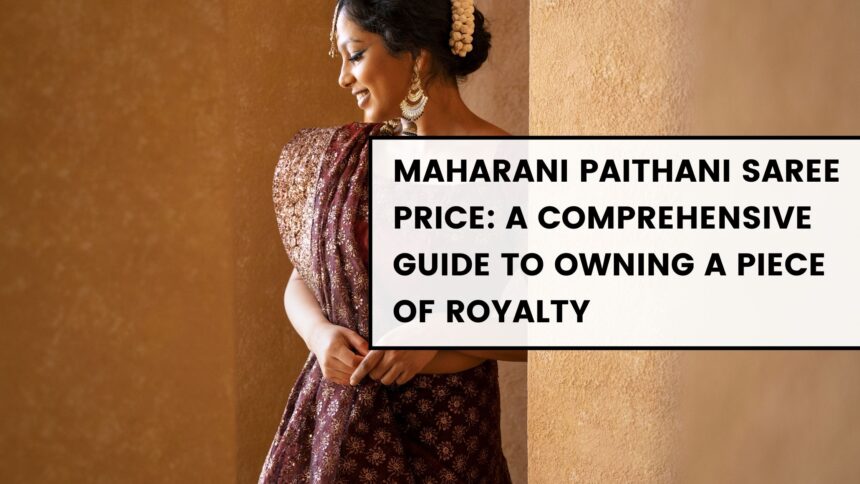Paithani sarees, particularly the Maharani Paithani, are known for their exquisite craftsmanship and royal allure. These sarees have long been considered a symbol of luxury, elegance, and tradition in Indian fashion. With intricate designs and vibrant colors, they carry a rich heritage that dates back centuries. But how much does a Maharani Paithani saree cost? What factors influence its price? Let’s dive into the details.
Understanding the Maharani Paithani Saree
The Maharani Paithani saree is more than just clothing—it’s a work of art. Originating from Paithan, Maharashtra, this traditional handwoven silk saree is known for its detailed patterns and motifs. Commonly, these motifs include peacocks, lotus flowers, vines, and geometrical designs, all intricately woven into the fabric.
The allure of a Maharani Paithani lies in its craftsmanship and the pure silk and zari (gold thread) used to create it. As a result, it’s no surprise that these sarees come at a premium price. But what exactly determines how much you’ll need to pay for one?
Factors Affecting Maharani Paithani Saree Price
Several factors play a significant role in determining the cost of a Maharani Paithani saree. Let’s explore each of these elements:
1. Material and Weaving Technique
The price of a Paithani saree largely depends on the materials used. Pure silk and genuine gold or silver zari threads can drastically increase the saree’s cost. A high-quality Maharani Paithani, made with pure silk and 22-karat gold zari, can range from INR 40,000 to INR 5,00,000 or even higher. Sarees woven with artificial or semi-silk and lower-quality threads are more affordable, ranging from INR 10,000 to INR 30,000.
2. Craftsmanship and Intricacy of Design
Maharani Paithani sarees are known for their complex and beautiful motifs. The more intricate the design, the longer it takes to weave. A saree can take anywhere between a month to a year to complete, depending on the intricacy, and this labor-intensive process reflects in the price. Handmade Paithanis, with designs like peacocks, asavalis, and parrots, command a higher price.
3. Authenticity of Zari
Zari threads are a hallmark of Paithani sarees, giving them their distinctive royal touch. Sarees made with real gold or silver zari are significantly more expensive than those made with synthetic alternatives. Authentic zari work is rare and can significantly boost the saree’s price.
4. Color and Pattern
Traditional colors like gold, royal blue, purple, and red are popular choices for Maharani Paithani sarees. Special patterns, such as the Narali border (coconut design) or the Bangadi Mor (bangle and peacock design), also influence the price. Rare patterns or colors may make the saree more desirable and, consequently, pricier.
Price Range of Maharani Paithani Sarees
The cost of Maharani Paithani sarees can vary widely depending on the factors mentioned above. Below is a general price range to guide you:
| Saree Type | Price Range (INR) |
|---|---|
| Standard Silk Maharani Paithani | 10,000 – 30,000 |
| Pure Silk with Silver Zari | 40,000 – 80,000 |
| Pure Silk with Gold Zari | 80,000 – 2,00,000 |
| Exclusive Designs (Custom-made) | 2,00,000 – 5,00,000+ |
Why Are Maharani Paithani Sarees So Expensive?
The rich history and skilled craftsmanship behind Paithani sarees contribute to their high cost. Maharani Paithanis, in particular, are crafted by highly skilled weavers who pass down the tradition from generation to generation. This process is slow and meticulous, making each saree a unique piece of art.
Handloom vs. Machine-made Paithani Sarees
A handloom Paithani saree is much more expensive than its machine-made counterpart because of the time and expertise required. Machine-made Paithanis, though cheaper, often lack the fine detailing and rich texture of handwoven ones. If you want a saree that stays true to the rich Paithani tradition, a handloom saree is worth the investment.
The Role of Gold and Silver Zari
Authentic Maharani Paithanis often use real gold or silver zari, which can push the price up dramatically. Real gold zari is rare and gives the saree its characteristic opulent look, making it a coveted item for special occasions like weddings.
FAQs About Maharani Paithani Saree Price
Why are Maharani Paithani sarees so expensive?
Maharani Paithani sarees are handwoven from pure silk and zari (gold or silver threads), making them labor-intensive to produce. The intricate designs and high-quality materials used contribute to their high price.
How can I identify an authentic Paithani saree?
Look for traditional motifs such as peacocks, parrots, and vines, and ensure that the saree is handwoven. Authentic Paithanis are also made from pure silk and real zari threads. Feel the texture—authentic handloom sarees have a softer finish compared to machine-made ones.
Where can I buy an authentic Maharani Paithani saree?
You can purchase authentic Maharani Paithani sarees from reputed stores in Maharashtra or trusted online retailers. Be sure to check for authenticity certificates and reviews before making a purchase.
Can I get a custom-made Maharani Paithani saree?
Yes, many weavers and retailers offer the option of custom designs and patterns. However, custom orders tend to be more expensive and may take several months to complete.
Are there affordable alternatives to Maharani Paithani sarees?
If you are on a budget, consider Paithani sarees made from blended silk or with synthetic zari, which can offer a similar look at a lower cost.
Conclusion: A Worthwhile Investment in Tradition and Luxury
Owning a Maharani Paithani saree is like owning a piece of India’s rich cultural heritage. While the price of these sarees can be steep, the investment is well worth it. Whether you choose a pure silk saree with intricate gold zari work or an affordable alternative, the beauty, grace, and craftsmanship of a Paithani saree will never go unnoticed.
If you’re in the market for one, start by understanding your budget and the factors that influence the cost. Look for authentic sellers and, if possible, invest in a handwoven saree that will last for generations. After all, a Maharani Paithani saree is not just a purchase—it’s an heirloom.
